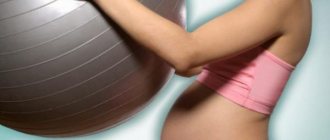Types of exercises for each trimester
As you know, different types of exercise and intensity of physical activity are suitable for each trimester of pregnancy. In principle, gymnastics requires an individual approach for each expectant mother, since many processes inside the body can take place differently and depend not only on the period. Below is a set of universal exercises that are safe for any pregnant woman, even if the woman did not devote time to exercise before conception.
What can you do in the first trimester?
Gymnastics begins with a short warm-up: the shoulders rise up as you inhale, and fall as you exhale; also, when inhaling, the shoulders are pulled back, and when exhaling, they return to their original position; You need to make circular movements forward and backward with your shoulders; The head bends forward and backward, from side to side; the head alternately “rolls” along the chest, shoulders and back in both directions.
After the warm-up, the main exercises are performed. For the first couple of minutes, you need to “walk in place,” then you should bend your elbows and move them first back, and then bring them together in front of your chest. A pregnant woman should also perform this exercise for a couple of minutes. After walking, you need to stop, restore your breathing and straighten your back, placing your hands on the back of your head and bringing your elbows together in front of you. As you inhale, your elbows spread in different directions, and as you exhale, they return to their original position. This exercise is repeated 6-8 times. Then the feet are placed shoulder-width apart, and the hands are placed on the belt, after which the body turns to the side while inhaling, and the hands rise up. As you exhale, the body must be returned to its original position, and then done the same, but in the other direction. The exercise should be repeated 3-5 times.
The following gymnastic exercises are performed in a sitting position. You need to carefully sit down on the floor, stretch your legs forward, and rest your hands on the floor behind your back. An exhalation is made, the legs bend at the knees, and when inhaling, they are spread in different directions, but the feet are connected. The knees come together again as you exhale, then as you inhale, lower them to their original position. Repetitions are done 6-8 times. For the next exercise, you need to rest your hands on the floor on opposite sides of your body, moving them back. The left leg is placed on the right, and then you should make circular movements with your foot in both directions alternately. After performing the exercise with your left leg, you should take the starting position, change legs and repeat everything with your right leg. You can perform up to 5 repetitions with each leg. After performing foot exercises, you need to take a position on your side, put one hand under your head, and stretch your legs straight. As you exhale, the knees bend and pull towards the stomach, and as you inhale, they straighten again. This exercise is performed 3-4 times.
Important: Nutrition during pregnancy: diet by week
Gymnastics must be completed with special exercises. A pregnant woman should lie on her back, bend her knees and place her feet on the floor. You must try to reach your chin to your chest, without lifting your head from the floor, but straining the back of your neck. Then you can train to spread your arms in different directions, but with your shoulders pressed to the floor. After this, you should place your legs flat on the floor, stretching and straining them, and spread your toes in different directions. Take a deep breath and at the end try to press your back, buttocks and the back of your head into the floor as much as possible.
Safe Exercises for the Second Trimester
In the second trimester of pregnancy, a woman can afford more intense physical activity. Her condition became stable, the risk of miscarriage significantly decreased, and toxicosis disappeared. The set of exercises for this period includes complex actions for the main stage of training, and the warm-up and final part remain the same as in the first trimester.
The main part of gymnastics exercises in the second trimester begins with 2-4 minutes of walking in one place. Then the pregnant woman should stand up straight and raise one hand up and the other to the side. As you inhale, one straight leg rises back, and as you exhale, it returns to its original position. You need to do 3-4 repetitions with each leg. After this exercise, you should take a straight position, squat slightly and move your arms back, and then return to the starting position. Do 4 to 6 repetitions. The next exercise requires you to take your arms back, connect them together and lower them down, while arching your chest forward, then return to the starting position. Do 4-6 repetitions at a time.
Additional information on the topic: Exercise during pregnancy
The next part of the exercises is performed while sitting on the floor. First you need to sit down and spread your legs in different directions, placing your hands on your belt. The right hand should touch the left leg as you exhale, and as you inhale, return to the starting position. The exercise is repeated 4-6 times for each hand. You also need to do several repetitions of the “cat” exercises: kneel down, exhale, lower your pelvis onto your heels and rest your hands on the floor. After this, move your hands behind your back, rest on the floor and raise your hips as you inhale. Then return to the starting position. You can do up to 3-4 repetitions at a time. Next, you need to do exercises to train your legs: lie on your back, bend your knees and extend your arms along your body. Then, while inhaling, raise and spread your legs, and while inhaling, lower them to the floor. You need to do 3-4 repetitions. After all the exercises, it is recommended to walk in one place again for 4 minutes.
Preparing for childbirth in the third trimester
In the third trimester, a pregnant woman is recommended to pay special attention to breathing exercises. At this time, it is important to reduce the intensity of physical activity and perform all exercises smoothly, avoiding sudden movements. Most of the actions in the workout complex for the third trimester are similar to the exercises for the second and first trimesters.
Gymnastics for a pregnant woman begins with 4 minutes of walking in one place, then you need to put your feet shoulder-width apart, put your hands on your lower back and, while inhaling, turn your body first in one direction and then in the other. At the same time, your arms should be raised up. After turning, the body returns to its original position as you exhale. The exercise can be repeated 3-5 times. Then the pregnant woman needs to take a position on her side, placing one hand under her head and stretching her legs straight. The knees should be bent as you exhale and pulled towards your stomach, and straightened again as you inhale. The exercise is repeated 3-4 times. Then the exercise is performed while sitting: the woman sits down and moves her hands behind her back, resting them on the floor, then very carefully first moves her left hand to her right with a turn of the entire body, then returns it to its place, and then the right hand to the left, also with the transfer of everything housings. You can do a total of 4 repetitions in one workout.
In the middle of the workout, you need to do 4 repetitions of the “cat” exercise. A pregnant woman should stand on all fours and sit on her heels as she exhales, and return to all fours as she inhales. A total of 3 repetitions are done. After the “cat” exercise, it is best to perform the exercise in a lying position: lie on one side, bend your lower arm at the elbow and place it in front of you, and extend the other along your body. As you inhale, the upper body rises up, and as you exhale, it returns to its original position. It is recommended to perform 4 repetitions on each side. The main set of exercises must be completed by walking in one place for 4 minutes.
What are the benefits of knee-elbow exercises?
At the 20th week of pregnancy, a pregnant woman can perform decompression (knee-elbow) gymnastics. In the literal sense of the word, a woman does not exercise, but at the same time brings great benefits to her body. The essence of this gymnastics is to stand on your elbows and all fours for 5-30 minutes. A pregnant woman can stand in this position several times a day to relieve pressure on the bladder, ureters and kidneys. As you know, as the period increases, the uterus begins to exert strong pressure on the internal organs, so this exercise becomes indispensable in the fight against constant discomfort in the expectant mother.
Performing cat pose for pregnant women
The knee-elbow position is very useful for a pregnant woman and her baby. However, the maximum effect can be achieved only if this exercise is performed correctly. Otherwise, there will be no proper result.
For convenience, it is recommended to perform the cat pose on a special gymnastic mat.
How to perform the knee-elbow position:
- Place one and then the other knee on the floor. Do the exercise smoothly and carefully.
- Place your palms on the floor. In this case, all the weight should go to the forearms.
- Bend your elbows. In this case, the stomach should hang freely.
- Try to arch your back. In this case, special attention should be paid to the shoulders and head.
- To support your head, you can rest your forehead on a pillow. This will make it more convenient for you to perform the exercise.
You can even wash the floors in this position. Collecting scattered spoons from this position is also useful. If done correctly, you can even lie on your back without experiencing discomfort.
mamafm.ru
Various factors play a role in the pathogenesis of pyelonephritis during pregnancy, while the mechanisms of hemo- and urodynamic disorders may change depending on the duration of pregnancy. An important role in the pathogenesis of pyelonephritis during pregnancy belongs to disturbances in the urodynamics of the upper urinary tract, the causes of which can be both hormonal and compression factors. In the early stages of pregnancy, a change in the ratio of sex hormones is noted, followed by a neurohumoral effect on alpha and beta adrenergic receptors, leading to a decrease in the tone of the upper urinary tract. The leading pathogenetic factor of pyelonephritis during pregnancy in later stages of pregnancy is considered to be the mechanical pressure of the uterus on the ureters.
In addition to the above mechanisms, urodynamic changes in the upper urinary tract, vesicoureteropelvic reflux, suppression of the immune system and genetic predisposition play an important role in the development of pyelonephritis during pregnancy.
Dilatation of the chest joint is noted from the 6-10th week of pregnancy and is observed in almost 90% of pregnant women. It is during these periods that hormonal dissociation occurs: the blood levels of estrone and estradiol increase significantly at 7-13 weeks, and progesterone at 11-13 weeks of pregnancy. At 22-28 weeks of pregnancy, the concentration of glucocorticoids in the blood increases. It has been established that the effect of progesterone on the ureter is similar to beta-adrenergic stimulation and leads to hypotension and dyskinesia of the upper urinary tract. As estradiol levels increase, alpha receptor activity decreases. Due to an imbalance of hormones, a disorder in the urodynamics of the upper urinary tract occurs, the tone of the jaw and ureters decreases, and their kinetic reaction slows down.
Impaired urine outflow due to atony of the urinary tract leads to the activation of pathogenic microflora, and possible vesicoureteral refluxes contribute to the penetration of microorganisms into the interstitial substance of the medulla of the renal parenchyma.
Thus, in pregnant women, inflammatory changes in the kidneys are secondary and are associated with impaired urodynamics of the upper urinary tract due to hormonal imbalance.
A change in estrogen concentration promotes the growth of pathogenic bacteria, primarily E. coli, which is caused by a decrease in lymphocyte function. In this case, pyelonephritis as such may not exist, only bacteriuria occurs. Subsequently, against the background of disturbances in the urodynamics of the upper urinary tract, pyelonephritis develops. An increase in the concentration of glucocorticoids in the blood at 22-28 weeks of pregnancy contributes to the activation of the latent inflammatory process in the kidneys that began earlier.
In late pregnancy, compression of the lower parts of the ureters (especially the right one) by the enlarged uterus leads to disruption of the outflow of urine from the kidneys. Disturbances in the urodynamics of the urinary tract in the second half of the period, when acute pyelonephritis most often occurs, most of the latter are explained by the dynamic anatomical and topographic relationships between the anterior abdominal wall, the uterus with the fetus, the pelvic bone ring and the ureters.
Compression of the ureter by an enlarged uterus rotated around the longitudinal axis to the right contributes to dilatation of the upper urinary tract and the development of pyelonephritis. It has been established that dilation of the upper urinary tract occurs already at the 7-8th week. pregnancy, when there is still no mechanical effect of the pregnant uterus on the ureter. It is believed that the greater the degree of dilatation of the upper urinary tract, the higher the risk of developing pyelonephritis during pregnancy. To one degree or another, a pronounced expansion of the pyelocaliceal system and ureter to the intersection with the iliac vessels is observed in 80% of pregnant women and in 95% of primiparas.
Disorders of the urodynamics of the upper urinary tract in pregnant women are often associated with fetal presentation. For example, compression of the ureters is noted in the majority of pregnant women with a cephalic presentation of the fetus and is not recorded in the breech or transverse position of the fetus. In some cases, impaired passage of urine from the upper urinary tract in pregnant women may be associated with right ovarian vein syndrome. In this case, the ureter and the right ovarian vein have a common connective tissue membrane. As the diameter of the vein increases and the pressure in it increases during pregnancy, compression of the right ureter in the middle third occurs, leading to disruption of the outflow of urine from the kidney. The expansion of the right ovarian vein may be due to the fact that it flows into the renal vein at a right angle. Right ovarian vein syndrome explains the more common development of acute right-sided pyelonephritis in pregnant women.
Vesicoureteropelvic reflux is one of the pathogenetic mechanisms for the development of pyelonephritis during pregnancy. Vesicopelvic reflux is observed in almost 18% of clinically healthy pregnant women, while in pregnant women who have previously suffered acute pyelonephritis, its prevalence is more than 45%.
Recent studies have shown that failure of the vesicoureteral segment and the occurrence of vesicoureteral reflux in pregnant women are caused by both hormonal imbalance and damage to the basement membranes of leiomyocytes of the urinary tract at all levels. Rupture of the calyx vault as a consequence of pelvic-renal reflux and urinary infiltration of the interstitial tissue of the kidney and urinary sinus that arises as a result of this are accompanied by acute circulatory disorders in the kidney and hypoxia of the organ, which also creates favorable conditions for the development of pyelonephritis.
Normally, when the bladder is filled naturally until there is a physiological urge to urinate, abdominal tension and bladder emptying do not cause dilatation of the collecting system, i.e. no reflux.
According to ultrasound data, the following types of vesicoureteral reflux in pregnant women are distinguished:
- when the abdominal press is tensed and the bladder is filled before a physiological urge occurs or after urination, an expansion of the collecting system is noted, but within 30 minutes after emptying the collecting system of the kidneys is completely contracted;
- when the abdominal press is tensed and the bladder is filled before a physiological urge occurs or after urination, an expansion of the collecting system is noted, but within 30 minutes after emptying, the collecting system is emptied only half of its original size;
- The pyelocaliceal system is expanded before urination, and after it the retention increases even more and does not return to its original size after 30 minutes.
During pregnancy, a restructuring of lymphoid organs occurs, which is associated with the mobilization of suppressor cells. Pregnancy is accompanied by involution of the thymus gland, the weight of which decreases by 3-4 times compared to the initial one by the 14th day of pregnancy. Hypotrophy of the gland persists for more than 3 weeks after birth.
Not only the number of T cells, but also their functional activity decreases significantly, which is associated with the direct and indirect (through the adrenal glands) influence of steroid sex hormones on it. In pregnant women suffering from acute pyelonephritis, a more pronounced decrease in the number of T-lymphocytes and an increase in the content of B-lymphocytes than in women with a normal pregnancy. Normalization of these indicators during treatment can serve as a criterion for recovery. In pregnant women with acute pyelonephritis, not only a decrease in the phagocytic activity of leukocytes and the phagocytic index is noted, but also an inhibition of nonspecific protective factors (a decrease in the content of complement components and lysozyme).
In the immediate postpartum period, not only the previous risk factors for the development of acute pyelonephritis remain as during pregnancy, but new ones also arise:
- slow contraction of the uterus, which can create compression of the ureters for another 5-6 days after birth;
- pregnancy hormones that remain in the mother’s body for up to 3 months after birth and support dilatation of the urinary tract;
- complications of the postpartum period (incomplete placental abruption, bleeding, hypo- and atony of the uterus);
- inflammatory diseases of the genital organs:
- urological complications of the early postpartum period (acute urinary retention and prolonged catheterization of the bladder).
Quite often, acute postpartum pyelonephritis is found in postpartum women who have suffered acute gestational pyelonephritis during pregnancy.
ilive.com.ua
How to increase your chances of conceiving?
Fertilization is influenced not only by the position chosen by the partners, but also by other factors: pathologies and diseases of the reproductive system of a woman or man, the date of intimacy, the lifestyle of the spouses and even actions after sexual intercourse.
To maximize your chances of pregnancy, follow these recommendations:
- Conception can only occur during ovulation, so a woman planning a pregnancy should know when this day comes. With a regular menstrual cycle lasting 28-30 days, a mature egg is released and begins its journey to the uterus approximately from the 14th to the 16th day. With a cycle length of 24-25 days, ovulation will most likely occur on the 12th or 13th day. But a more reliable way to determine the moment of maturation of the female reproductive cell is to use ovulation tests.
- When using the conception positions described in the article, it is important to behave correctly after intimacy, otherwise the likelihood of fertilization will significantly decrease. Some gynecologists advise patients to raise their legs up and take a “birch” position so that sperm moves faster along the cervix and eventually penetrates into the organ cavity for further fertilization. But this is not always appropriate or convenient, so you can simply lie down after sexual contact: in this case, the ejaculate will also linger in the vagina, which will increase the chances of pregnancy. Better yet, raise your pelvis by placing a pillow or folded blanket under it.
- If you want to get pregnant, you should not shower or thoroughly wash your genitals immediately after intimacy with your partner. Soap will change the acidity of the vagina and make it unfavorable for the advancement of sperm. It is better to wait a while and then move on to hygiene procedures.
- If a woman has experienced pleasure, this will increase the likelihood of pregnancy, since contractions of the muscles of the walls of the vagina and uterus will promote the advancement of sperm.
- At the stage of pregnancy planning, visit a gynecologist and undergo a comprehensive examination to assess hormonal levels, determine the state of the reproductive system and identify pathologies that impede fertilization.
- Lead a healthy lifestyle and avoid stress. A woman's good health will contribute to fertilization and successful pregnancy.
The right position will help increase your chances of conception. But it is important to start preparing for pregnancy in advance, since fertilization is influenced not only by position, but also by other important factors.
(votes: 4, rating: 4.00 out of 5)
Share the news on social networks
Ask a Question! You have questions? Feel free to ask any questions! And our staff specialist will help you. Go>>
Tags:
- Recommended Articles
- Why do breasts hurt after conception?
- Is it possible to get pregnant with polycystic ovary syndrome?
- Is it possible to get pregnant after a caesarean section?
« Previous entry
Breathing exercises during pregnancy
Breathing exercises must be included in the training complex for pregnant women. It can be performed before physical exercise, or done in parallel with gymnastics. It is important to note that the entire set of breathing exercises can last no more than 10 minutes a day. The fact is that in the process of working on breathing, a pregnant woman actively saturates the entire body with oxygen, which displaces carbon dioxide. From a physiological point of view, the body reacts negatively to such a ratio of oxygen and carbon dioxide - dizziness, low blood pressure, drowsiness and weakness. Naturally, such side effects are undesirable for the expectant mother.
The main goal of breathing exercises for a pregnant woman is to prepare her for the upcoming birth, where she should be able to control her own breathing. With the help of special exercises, the expectant mother can learn to increase the amount of oxygen in the blood, thereby improving overall blood circulation in all tissues and organs. The normal functioning of a woman’s organs and the absence of problems with blood circulation have a positive effect on the development of the fetus and the course of the birth process.
It is worth noting that the acquired skills of proper breathing can be useful after the birth of a child, for example, special breathing helps to reduce body weight. It is easy for any pregnant woman to master breathing techniques, since the main thing is to control inhalation and exhalation. When performing exercises, it is important to take into account that an enlarged uterus will interfere with the full movement of the diaphragm, so the woman needs to get used to abdominal breathing.
A set of exercises for breathing exercises:
- “diaphragmatic breathing” - one hand is placed on the ribs, and the other on the stomach, then a deep, quick breath is taken through the nose. In this case, the diaphragm should go down, thereby protruding the stomach, after which you exhale through the mouth or nose. The pause between breaths should be no more than 1 second;
- “chest breathing” - hands are placed on the ribs and a deep breath is taken through the nose. During this exercise, a woman should try to breathe only from her chest. When the chest is completely filled with air, you need to exhale slowly;
- “doggy breathing” - a pregnant woman should get on all fours and stick out her tongue, while breathing through her mouth and as often as possible;
- “four-phase breathing” - inhale through the nose for 4-6 seconds, then hold your breath for 2-3 seconds, and only then exhale for 4-6 seconds. You need to breathe in this way for at least 2-3 minutes.
The above breathing exercises should be performed only 2-3 cycles, and the duration of exercises should be increased gradually. As you know, no more than 10 minutes can be devoted to this gymnastics during the day. It is worth highlighting Strelnikova’s breathing exercises, whose set of exercises initially had nothing to do with pregnancy. The purpose of the ball exercises is aimed at training the vocal cords and developing the voice, but, as experience has shown, they may well be useful during pregnancy.
Good to know: Fetal development by week of pregnancy
Are there any contraindications for this method?
This method is good not only because it does not require any costs or auxiliary means, it also has no contraindications.
Unless your pregnancy has any special complications, then consult your doctor, but he is unlikely to consider the knee-elbow position dangerous for you or the baby.
If you perform knee-elbow gymnastics correctly, then it has no absolute contraindications. If you experience any discomfort, dizziness or headache during exercise, you should immediately change your position. To avoid discomfort, it is necessary to increase the load gradually. You should start by maintaining the position for 5 minutes, then you should gradually increase the duration to 15-30 minutes.
Limitations to the exercise are spinal injuries that do not allow flexion and extension of the back. Care must also be taken in case of neck injuries - do not include it in the process, leaving it in line with the spine. If you feel severe discomfort, you should consult a doctor.
How does this method work?
When the expectant mother is in the knee-elbow position, the uterus, due to the normal force of gravity, moves forward and down, releasing all internal organs, blood vessels and the spine from its pressure.
Blood circulation in the internal organs temporarily improves, the functioning of the bladder and kidneys improves, swelling disappears (or the possibility of its occurrence), pressure on the inferior vena cava disappears, the woman becomes able to breathe easier, and the spine “rests.”
In addition, this position is also useful for the baby: by improving blood circulation, more oxygen reaches the baby.
Limitations when performing the exercise
Despite the simplicity and absence of contraindications, positional therapy still has its nuances. When performing the "cat" exercise, monitor your well-being. Avoid this technique if you feel a headache or dizziness while resting on your elbows and knees. If there is discomfort that cannot be eliminated even by performing the exercise correctly, consult your doctor.
When else should positional therapy be limited:
- for spinal injuries, when it is difficult to bend and straighten the back;
- in case of neck injuries, make sure that it is in line with the spine;
- for problems with knee joints.
Also keep in mind that you cannot exercise on a full stomach.
Benefits of the knee-elbow position for the fetus
This exercise is famous for being quite effective. Moreover, it will always help keep the body in good shape, stimulating the work of not only muscles, but also ligaments, and generally preparing a woman for the upcoming birth. It is for this reason that you should not ignore them, trying to perform them competently and correctly.
As a rule, this position is necessary for those mothers who face certain problems during pregnancy. This may include swelling, cystitis, and other disorders. It just seems that the pose on all fours is a simple pose and doesn’t do anything supernatural or special, but that’s just what it seems.
Please note that at this moment there is no excess pressure on organs such as the kidneys and bladder. It is also impossible not to appreciate the fact that at this moment urine really begins to be excreted better, and as for blood circulation in the pelvic organs, it improves significantly, reducing the risk of inflammatory and congestive phenomena, which cause many problems for pregnant women.
In addition, this exercise is ideal for preventing toxicosis - this is a common ailment among pregnant women, which mothers want to get rid of as soon as possible. By performing this exercise, you can normalize the condition of the internal organs and systems that actually lead to the development of this pathology.
Remember that this is a good and effective preventive measure that allows you to prevent the development of certain complications and discomfort. Exercise will help get rid of excess stress on muscles and ligaments that a pregnant woman does not need.
Regular use of CLP is beneficial not only for the expectant mother, but also for the baby. It allows you to normalize uterine blood flow, which promotes a greater supply of oxygen and nutrients to the fetus and improves its cardiac activity. When taking the knee-elbow position, the child begins to move more actively or calms down - this is how he reacts to changes in blood circulation.
The knee-elbow position is prescribed for breech presentation. Childbirth in this position of the fetus is considered pathological, since it can serve as a basis for a cesarean section and lead to a number of complications.
How does pyelonephritis manifest in pregnant women?
- Some women have no complaints, and changes are detected exclusively during laboratory examination - leukocytes and bacteria in the urine. When sowing, the growth of Escherichia coli is most often determined, less often - Klebsiella and Staphylococcus, Proteus. Pyeelectasis may be detected on ultrasound.
- There are frequent complaints of aching pain, heaviness in the lower back, usually asymmetrical, and there is often an increase in pain with prolonged standing on the feet. Some people note chilliness in the lower back.
- During exacerbation, the temperature may rise. More often - a slight low-grade fever, especially in the evening, but in some cases there are rises to 38-39 ° C.
- Frequent urination and nocturia are typical for a normal pregnancy, but with pyelonephritis, the urge may become imperative and urination may be painful.
- A frequent companion to pyelonephritis is high blood pressure. Moreover, if blood pressure above 140/90 mm is usually a signal of trouble. Hg column, then for a pregnant woman 130/80 is already too much.
- Pregnant women notice swelling of the legs quite often; this is not necessarily associated with a pathology of the urinary system, but can serve as a sign of impaired venous outflow, however, with pyelonephritis, the swelling intensifies, a puffy face often appears, and the hands swell.
- Headaches even with normal blood pressure, fatigue, a feeling of exhaustion and weakness, especially in the morning, complete the picture.
Why is it so important to do gymnastics during pregnancy?
Pregnancy is a tiring period of time for the female body, but childbirth is an even more serious test for which it is necessary to prepare. By performing special exercises, the expectant mother stimulates blood circulation in the internal organs that need healing during pregnancy. Thanks to good physical preparation, a woman has every chance to avoid ruptures and other injuries to the perineum. That is why the set of exercises for pregnant women pays great attention to training the muscle tissue of the perineum directly. It is worth noting that gymnastics also helps to cope with toxicosis, since the purpose of some exercises is to cleanse the body.
Gymnastics for pregnant women also helps prepare you psychologically for childbirth. The expectant mother needs to make not only physical efforts, but also properly tune in to childbirth in order to feel healthy. In the process of doing the exercises, a pregnant woman can mentally tune in to the fact that the pregnancy and birth of the child will go well. Psychologists recommend viewing gymnastics as a kind of game, for example, treating each organ as a separate living organism that has its own consciousness. This is especially true for the uterus, since within 9 months it becomes a home for the baby, protecting and protecting him. The expectant mother should often put her hands on her stomach, stroke it and mentally thank the uterus for its functions, for the fact that it nourishes and helps the child. A woman can not only physically influence her body, but also “think” on each organ, the main thing is to remember that it is also necessary to interact with the baby in the womb. A pregnant woman’s sense of her own beauty, strength and health is easily transferred to her child, so competent gymnastics is therapy for a developing organism.
In what cases is gymnastics contraindicated?
Any physical exercise should be previously agreed with your doctor, as in some cases it may be contraindicated for the expectant mother. Most often, gymnastics for pregnant women is strictly prohibited with a diagnosis of “threat of miscarriage” and severe complications - toxicosis and gestosis. Gymnastics is contraindicated for a woman with regular and sudden changes in blood pressure, as well as with constantly very high or low blood pressure. Exercise can also cause complications during the development of the fetus if its mother is experiencing a period of exacerbation of a chronic disease. Physical activity is strictly prohibited if an acute inflammatory process of any nature occurs in the female body. In addition, an expectant mother who has experienced a miscarriage or premature birth will have to give up gymnastics.
Safety precautions when performing exercises
The expectant mother should not severely limit her physical activity in the absence of medical contraindications. Pregnancy is a natural process, but, unfortunately, very often modern women can encounter complications and pathologies of various types that are incompatible with physical activity. That is why, for safety reasons, the expectant mother is obliged to consult with her personal gynecologist, agreeing on the safest exercises for her body. In addition, it is necessary to take into account the duration of pregnancy, since only a certain set of exercises and intensity of physical activity are suitable for each trimester. In any case, it is also important to take into account the convenience of the exercise technique for a particular woman.
The expectant mother is strictly prohibited from performing exercises for the abdominal muscles, jumping and exercising on weight machines. If pain or even mild discomfort occurs, you should immediately stop physical activity. You should seek help from a doctor if you experience nagging pain in the abdomen and increased heart rate. Most often, a physically unprepared pregnant woman may feel a rapid heartbeat under heavy loads, which also requires stopping training. That is why it is recommended to initially perform any exercises at half strength without tiring the body. As you know, the load during training and gymnastics must be increased gradually, avoiding sudden movements. That is why a pregnant woman should perform the exercises smoothly and slowly until it causes her discomfort. It is even important to lie down and sit up from a lying position carefully and gradually.
Indications and contraindications
The knee-elbow position is indicated for the following conditions:
- exacerbation of osteochondrosis - restricted movements, pain in the lumbar region;
- impaired urine outflow - edema, cystitis, pyelonephritis, etc.;
- disorders in the functioning of the digestive tract - flatulence, constipation, etc.;
- varicose veins of the extremities and rectum;
- development of gestosis;
- disorders of the uteroplacental circulation, pathologies of the placenta;
- disorders of the heart and blood vessels.
This pose has virtually no contraindications, so with its help every woman can improve her well-being without taking any medications.
Effective positions in gymnastics for pregnant women
Positional gymnastics is considered the most useful and safe during pregnancy, since it was specially designed for expectant mothers, taking into account their physiological characteristics and needs. The main task of the positions and exercises is to train the female body for the upcoming birth. In the process of performing the exercises, all muscle groups that will be involved in childbirth are prepared. Mainly positional gymnastics uses the muscles of the back, abdomen and pelvis, and also trains the muscles of the perineum - the part of the body most prone to injury during childbirth. Positions:
- exercise “cat” - you need to get on all fours, round your back, lowering your head as far down as possible, and then lift it up and arch your back;
- “Twisting” exercise - it can be performed both sitting and standing, while the body must be rotated first in one direction and then in the other. At the same time, the arms open in different directions, and the pelvis remains motionless;
- “Butterfly” exercise – while sitting on the floor, bend your knees and put your feet together, place your hands on your knees and press your palms on them until a slight stretch is felt. An important point: when performing exercises, you cannot increase the pressure too much to avoid pain;
- “pin” exercise – helps to develop the muscles of the perineum, as well as manage them, making them firm and elastic. To do this, you need to tense your muscles, as when holding back urination, and then relax them.
Fitball exercises for pregnant women
Performing special actions on a large ball - a fitball - has become a popular and effective method of preparing for childbirth in recent years. It is quite natural that many pregnant women prefer to prepare for childbirth with the help of a fitball, since exercising with it is much simpler and easier. It is worth noting that training of this kind should be done only with the permission of a gynecologist and under the guidance of an experienced specialist, and in the first trimester the load should be minimal. In that case, if the expectant mother did not play sports before conception, it is better for her to wait to train on a fitball until the second trimester - a safer period.










